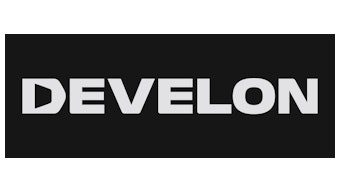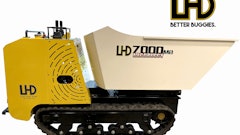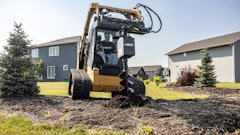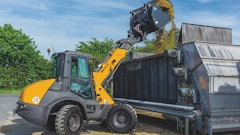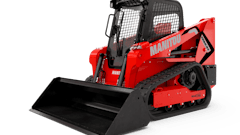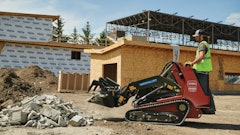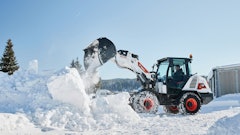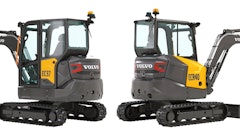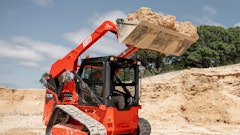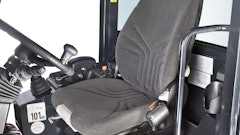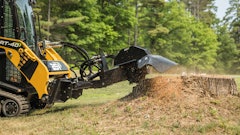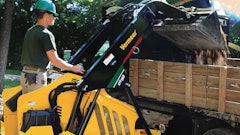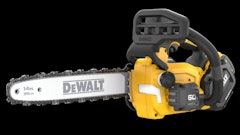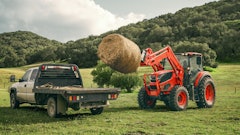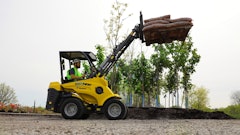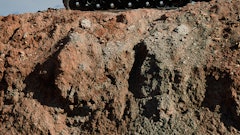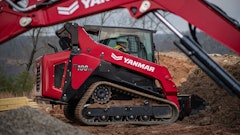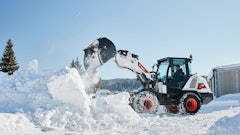
While skid steers and compact track loaders are extremely maneuverable and can perform tight turns – they sometimes lack the size needed for certain jobs. Conversely, full-sized, heavy-duty wheel loaders are often too large for specific jobsites. This is where compact wheel loaders enter the fray. They frequently offer the perfect balance of size, power and capabilities for a range of landscaping projects.
Compact wheel loaders also boast efficient operational costs and a wide range of useful features and attachment options. While a compact wheel loader may cost more upon initial purchase than a skid steer, its operating costs can save you money over time. This is due to lower fuel consumption, fewer maintenance requirements and higher resale values.
It's easy to see why compact wheel loaders are taking such a prominent place on landscaping jobs and construction projects. But how do you know if a compact wheel loader is the ideal piece of machinery for your project, and how do you choose the best one? We spoke with product experts from some of the leading equipment manufacturers about how these machines have evolved over time, what options and features are available and how to choose the right model for your needs.
Selecting the Right Size
The size of a compact wheel loader is crucial to performance. “Tight turning circles and visibility must be considered when determining the size of the loader, as well as production requirements,” says Hitachi Construction Machinery Loaders North America product specialist Nathan Little. “Operating safely is priority one.”
Selecting a compact wheel loader that is the right combination of size and power for your needs depends on a range of variables. When choosing between available machines, AMS-Venieri territory manager Manny Mendez says it's important to understand the full specs you're comparing.
“There are a lot of factors that go into [choosing a compact wheel loader], and it’s important to remember that bigger isn’t always better," Mendez says. "For example, hydraulic pressure (gallons per minute flow) will matter greatly depending on the needs of specific attachments that require auxiliary hydraulics. Contractors should also take into consideration the jobsite topography. An articulation-type center joint on a wheel loader will bring better traction in unfavorable conditions."
“The type of work environment and the ground conditions in the majority of the applications determine what kind of differential gear should be selected — limited slip, locking or torque proportional,” Little points out. “This will be a big factor in the wheel loader efficiency depending on the ground conditions, particularly in mud, clay or gravel.”
“All applications and jobsites are unique and have their own sets of needs and challenges," says John Deere Construction compact wheel loader product marketing manager Grant Van Tine. "Jobsite space constraints or limitations may require contractors to choose a compact wheel loader that meets a particular machine height, width, length or turning radius specification. Bucket capacity or lift capacity requirements will also influence machine sizing.
"Knowing the material type and density is essential to determine the appropriate machine and bucket selection," he continues. "Some applications may have specific dumping or lifting height requirements, which may drive the need for a specific machine size or a high lift option.”
“When right-sizing a machine, business owners and fleet managers need to know the weight and density of the material being moved,” Case Construction Equipment product marketing manager Andrew Dargatz agrees. “They need to know what size bucket they plan on using, what size trucks/hoppers they’ll be filling, etc.”
Factors such as material weights, truck height or hopper height and target bucket size can affect more than size requirements. "These factors will help determine the size of the loader needed," Dargatz says. He also adds, "Selecting the various application-specific options such as axles and transmission type will more directly impact cycle times and maximize production.”
How Have Compact Wheel Loaders Evolved?
All of our consulted experts agree that compact wheel loaders on today's market offer far better attachment capabilities and more useful features than machines from the past.
“Over the past decade, the growth in attachment offerings has helped make compact wheel loaders more productive and versatile machines,” says Van Tine. “Compact wheel loaders are capable of operating so much more than buckets and forks. When equipped with a skid-steer-style coupler, [they] can operate many of the same attachments commonly used by a skid steer or compact track loader, such as pick-up brooms, root rakes, snow blades and snow blowers, just to name a few.”
Improvements in visibility, cab comfort and ride quality also make the loaders a preferred tool among operators for running attachments, he adds.
"[Compact wheel loaders] have evolved from a single tool (i.e., bucket only) machine into multi-tool machines. These new machines quickly adapt to augers, forks, multiple-use buckets, blades and many other tools," says AMS-Venieri's Manny Mendez. A universal skid-steer attachment plate, such as the one offered by the VF2.63C, further outfits compact machines to take on virtually any job with no customizations required.
“With all the new attachments — buckets, snow brooms, brushes and grapples — coming to market, the Hitachi compact loaders have been engineered for flexibility in multiple applications and environments,” notes Little. “One Hitachi loader can utilize dozens of different attachments interchangeably. Without having to get out of the comfort and safety of the cab, these changes can be made with the push of a button.”
Versatility has been aided by advances in the controls, as well. Dargatz says, “Case has recently updated its compact wheel loader lineup with new adjustable electrohydraulic controls. This added functionality allows operators to adjust the responsiveness of the lift and tilt bucket functions for improved control, efficiency and versatility on the jobsite.”
What Features and Options Are Available?
Manufacturers of compact wheel loaders continue to add more useful features and options to provide landscapers and other operators with everything they need to get projects done.
“Lift and tilt settings can now be adjusted with two new three-way rocker switches (high, medium or low) mounted on the side console, allowing operators to adjust the responsiveness of the loader lift arms independently of the attachment tilt functions,” says Dargatz. These new adjustable settings enable users to program the machine’s response based on their personal preferences or job demands.
Options available on Case Construction Equipment’s compact models include new electrohydraulic controls and an E-inching pedal. The electrohydraulic controls offer automated bucket metering functionality, providing operators more precise and consistent movement of the bucket edge while metering or sifting material into a truck or feed wagon.
“The E-inching pedal uses an electronically-controlled inching valve to provide greater response and more control in applications where the operator requires precise movements at slow speeds," Dargatz notes. "The pedal has also been ergonomically positioned for improved operator comfort.”
“There are numerous options available to tailor compact wheel loaders to meet the needs of specific jobsites or operating conditions,” Van Tine comments. “Contractors planning to use hydraulic attachments will appreciate features like creep control, throttle lock and high-flow hydraulics to maximize machine performance and controllability.”
Both skid-steer-style and ISO-style couplers are also available based on customer preference and attachment compatibility.
Other Considerations
Consider all available features and options when choosing a compact wheel loader for your projects. For example, operator comfort can have a big impact on productivity. Climate control, air suspension seats and ride control can help combat operator fatigue, while other features, such as rear view cameras and LED lights, may be needed to help improve visibility for certain jobs, says Dargatz.
“Contractors who perform work early in the morning or late at night (such as snow removal) will especially appreciate LED work light options to brighten their jobsite,” Van Tine notes.
Other features to keep in mind include:
- High lift options for applications that require additional lift and reach capabilities
- Reversing fan options for high debris applications to keep the cooling package clean and maximize machine uptime
- Guarding options such as window guards and rear machine guards that help protect the machine in certain applications and environments
- A boom-height kick-out option, which can increase productivity and efficiency for machines performing a lot of repeat loader work, such as loading, lifting and dumping or stacking
Dargatz offered a few other considerations to ensure you find the unit best tailored to your needs. They include:
- Ground line serviceability to help ensure daily service checks are completed
- Tier 4 Final solutions, such as selective catalytic reduction and diesel oxidation catalyst systems, that eliminate the need for regeneration and any downtime associated with the regeneration process
- Other features that reduce overall downtime
“It’s all about what’s easy and what will keep the machine up and not down,” says Mendez. This includes ease of operation, access to all the moving parts for maintenance, factory support, operator and technician training and the ability to easily change attachments.
Finally, take transportability into consideration. “If contractors intend to transport their compact wheel loader frequently from jobsite to jobsite, they will also consider machine weight and other key shipping dimensions for trailering purposes,” says Van Tine.





